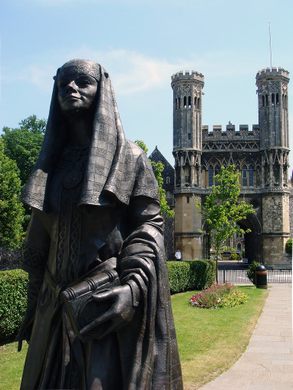AO Edited
Queen Bertha and King Æthelberht
Today, Kent's medieval monarchs hold court on a busy pedestrian thoroughfare—or at least their statues do.
The sculptures of a mustachioed warrior king and queen from the Middle Ages stand ready to knight any of the busy passersby in the city of Canterbury. Unfortunately, few stop to take in the royals.
During the period of Anglo Saxon rule of England, separate kings ruled over nine different regions. The Saxon territories traded, made alliances, and (when those alliances didn’t work out) waged wars against one another.
King Æthelberht ruled the kingdom of Kent from his capital in Canterbury from 589 to 616. Æthelberht was a pagan and worshipped a pantheon of deities, such as Woden the king of gods (roughly analogous to the Viking Odin), Thunor god of thunder, Frige the goddess of love, and Tiw the god of war.
Queen Bertha was neither English, Saxon, nor pagan. She was a Christian, Frankish princess. Bertha arrived in England from France when her father, King Charibet of the Franks (who then ruled the region of Paris), married her off to Æthelberht. Charibet hoped the marriage would secure him a military and economic alliance between Kent and his Frankish kingdom.
Bertha was eventually able to convince Æthelberht to convert to Christianity. The pair became some of the first Christian Anglo-Saxon monarchs of England. They soon proselytized the new Christian faith, even inviting Rome’s Saint Augustine to help spread Christianity in England. While Christianity spread to England as soon as the first century, Augustine’s mission helped to further establish a formal Christian presence on the island.
Local sculptor Stephen Melton carved the statues of the historical power couple, which were unveiled in 2006.
Know Before You Go
The statues may be seen for free on Lady Wootton's Green close to Canterbury Christ Church University
Community Contributors
Added by
Edited by
Plan Your Trip
The Atlas Obscura Podcast is Back!




















Follow us on Twitter to get the latest on the world's hidden wonders.
Like us on Facebook to get the latest on the world's hidden wonders.
Follow us on Twitter Like us on Facebook